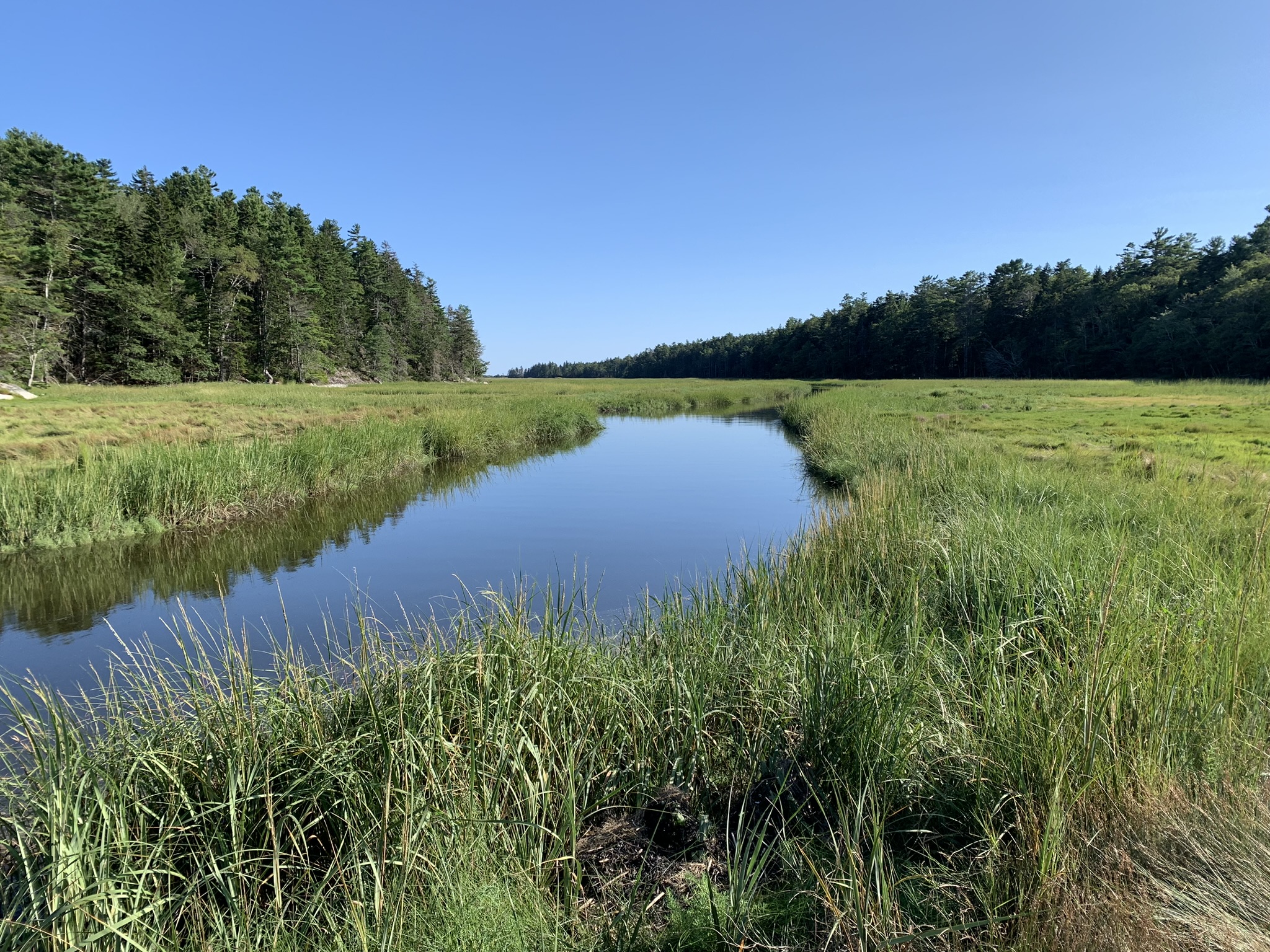
From Methane Emissions to Carbon Sequestration: The Stories Tidal Marshes Tell
How Maine scientists are reading the carbon story in salt marshes—and why restoring tidal flow may be a key to climate resilience.
In 2022, Maine Sea Grant funded a study led by Beverly Johnson (Bates College) and Claire Enterline (Gulf of Maine Research Institute), measuring carbon gas emissions (methane) and carbon absorption in marshes along the Maine coast at sites where tidal flow has been restricted. These data give researchers and resource managers a better understanding of how marsh restoration efforts could help Maine reduce carbon emissions and achieve goals laid out in “Maine Won’t Wait,” Maine’s four-year climateaction plan.
Science You Can Feel in Your Bones
Beverly Johnson, the Charles A. Dana Professor of Earth and Climate Sciences at Bates College, has been taking students out to tidal marshes to help with her research for over 25 years. While her research topics have evolved over the years, under Johnson’s wings, the research is always technical, experiential, and fun.
As part of their fieldwork, Johnson sometimes takes students to the unrestricted side of the marsh, jumps, and asks them, “Can you feel that?” Then, she’ll take them to the degraded side of the marsh, where tidal flow is restricted by an undersized culvert under a road crossing, and jump again, asking, “And how about that?”
If you’re not paying attention, it may look as though Johnson is checking her students’ knee reflexes, but what she’s actually doing is demonstrating a way of corroborating–through the body–what she’s uncovering through her more technical research.
“If someone jumps near you in a salt marsh, it propagates a wave of energy that moves toward you,” Johnson explains. “If the marsh is healthy, the roots are intact and the peat is firm; the energy from that jump gets stopped, and you would barely feel it. But if the ecosystem is degraded, what is referred to as a ‘rotten marsh,’ that energy propagates under you. It’s like a weird trampoline, moving you up and down because the soils are destabilized and can’t intercept that energy.”
The state of Maine is home to more than 157,500 acres of tidal marshes. Healthy tidal marsh ecosystems are carbon sinks, providing habitat for plants that absorb carbon from the atmosphere. While forest ecosystems are often touted for their carbon-storing capabilities, thriving tidal marshes can store carbon four to 10 times more efficiently than forested ecosystems.
Yet, an estimated 90% of tidal marshes in Maine are tidally restricted, meaning physical structures such as roads, railroad crossings, or other historical structures are impeding or preventing the natural flow of tides between upstream and downstream areas. Loss of the tides can result in degradation of the salt marsh and emission of greenhouse gases containing carbon, rather than sequestration (or retention) of the carbon-rich organic matter in the marsh soil. The good news is that salt marshes can respond quickly to restoration efforts if done properly, and can be a part of the solution for increased coastal resilience.While it’s known that degraded salt marshes can release greenhouse gases carbon dioxide (CO2) and methane (CH4) into the atmosphere and adjacent waters, how much is released and where remains an important area of study–this is what Johnson and colleagues set out to understand with funding from Maine Sea Grant.
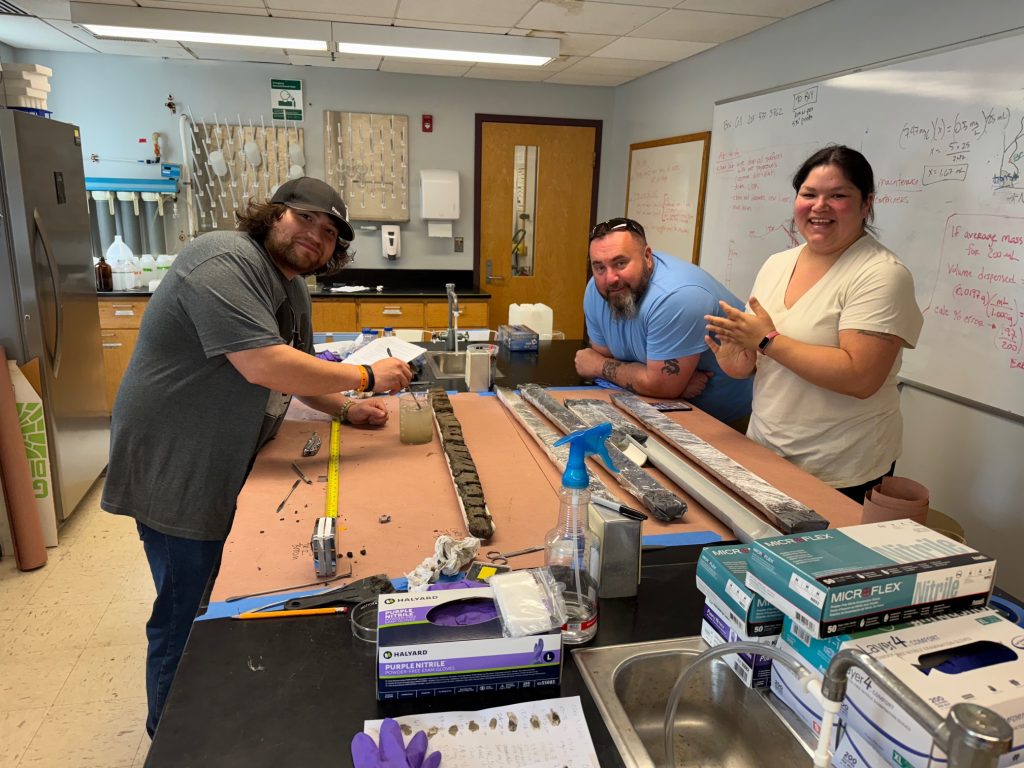
A Landscape Shaped by Time (and Humans)
Most of the time, tides come in and out of the stream channel, but four to six times a month (during full and new moons as well as during storm events), tidal marsh systems get flooded, and the tide rises up onto the marsh surface and deposits sediment. Grasses that grow in salt marshes are incredibly salt-tolerant and grow up through the fresh sediment on the marsh surface. This constant back and forth of sediment deposition and plant growth have helped entire tidal marsh ecosystems to keep pace with sea level rise and are part of what makes them such a powerful buffer during storm surges.
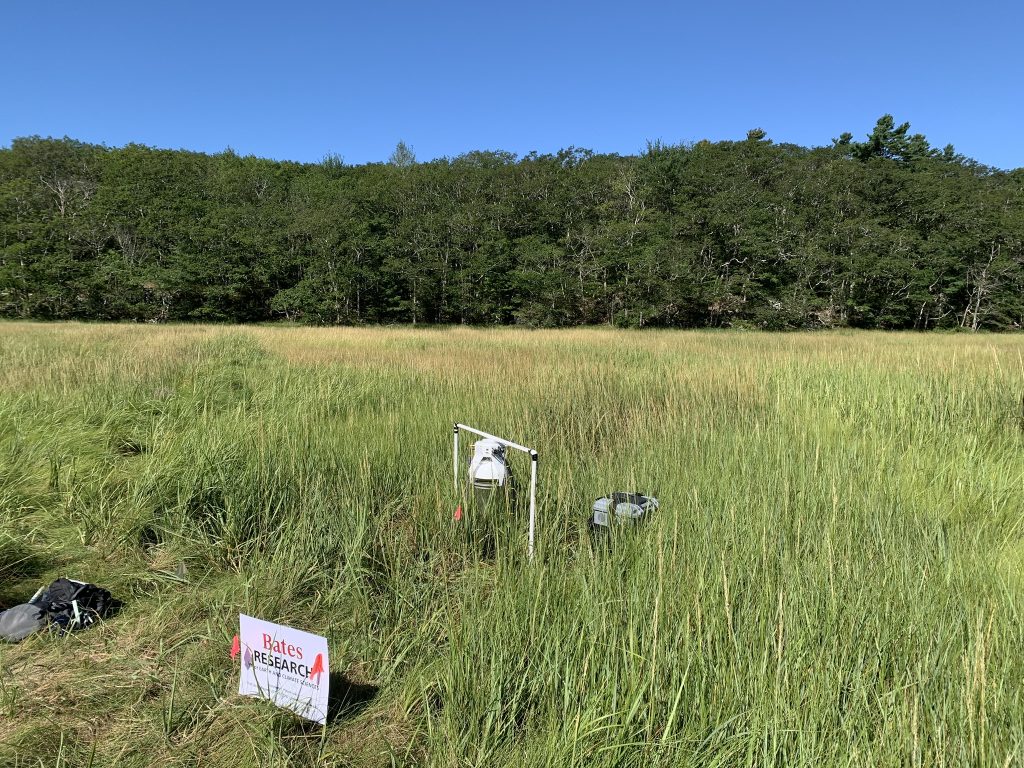
These amazing systems have been altered for centuries. European settlers used salt marshes as grasslands, harvesting the grass to feed cattle and insulate their homes. Ditches were dug in an attempt to drain the water more efficiently. Even after salt marshes ceased being used for haying and in some cases, cattle grazing, landowners continued ditching, in (largely unsuccessful) efforts to reduce mosquito habitat. Farmers also built embankments with tide gates so they could drain and farm the organic and nutrient-rich marsh soils. The implementation of the Clean Water Act in 1972 prevented further destruction of salt marshes, but existing ditches and embankments don’t necessarily disappear without concerted effort, and tidal restrictions vis-à-vis road and railway crossings continue to threaten these essential habitats. Many of these structures continue to impact today’s marshes. Draining of marsh soils accelerates degradation and subsidence of the marsh surface, and pooling water upstream of tidal restrictions can change the bacteria in the soil and promote release of CH4, a greenhouse gas that is 35x more effective at trapping heat than CO2.
Unearthing the Carbon Story
While much can be learned about a tidal marsh from visual observation and exploration, there’s a lot more under the surface. This is what Beverly Johnson and her students set out to explore through this Maine Sea Grant-funded study—collecting sediment cores, looking at methane emissions, hydrology, vegetation, soil carbon, and long-term sedimentation on both sides of tidal restrictions.
Maine Sea Grant’s support for Johnson’s study funded both equipment (a state-of-the-art portable greenhouse gas analyzer manufactured by LI-COR) and a cohort of four students working across four tidally restricted marshes, including Sprague Marsh, part of the Bates-Morse Mountain Conservation Area in Phippsburg.
The degree to which carbon sequestration is impeded (and methane is emitted) by the presence of a tidal restriction depends on the characteristics of the site. At one site, the tidal influence was relatively consistent above and below the tidal restriction, and carbon sequestration was high and methane emissions were low throughout. At two other sites, including Sprague Marsh, the tides were significantly restricted, soils were waterlogged with lower salinities, and methane gas emissions were significantly higher above the restriction. At the fourth site, the system was very degraded upstream of the restriction. Johnson and colleague’s work implies that the first site is functioning well, and that the other three sites are not and would be good candidates for tidal restoration from a carbon perspective.
In 2025, findings from the Maine Sea Grant project were leveraged to secure part of a grant from the Maine Community Foundation, enabling Johnson and her team to expand to a fifth site: Sipayik (Passamaquoddy Pleasant Point Reservation). Here, Indigenous and Western scientific approaches are being combined to study the carbon dynamics and history of Kcipeskiyak, the coastal wetland currently sandwiched between a road and a railroad crossing in Sipayik. Johnson is actively training members of the Sipayik Environmental Department to independently collect and analyze their own sediment cores, enabling them to determine carbon stocks and sequestration and to reconstruct the wetland’s history prior to installation of the road and the railroad crossing.
Johnson and Enterline are analyzing all of the data to determine whether there are consistent influences on methane emissions across all of the sites. They initially hypothesized that the study would allow researchers to make transferable estimates of how much methane is emitted upstream of certain types of tidal restrictions, and the precise benefits of what could be gained if tides were restored well. However, at this point, what Johnson and her students have found within the sites, is that every marsh is different and that the carbon story is not always consistent.
The research has surprised Johnson in other ways, too—for example, that marsh systems, under the right conditions, recover more quickly from human alterations than she thought they would. In addition, Johnson notes an increased appreciation for how powerful plants are. Through the research, Johnson and her students measured CO2 uptake by plants by analyzing CO2 concentrations in a clear chamber placed over plants. Over the course of one minute, Johnson says, CO2 in the chamber decreases significantly—all because it’s being converted into plant biomass, much of which is shunted into the roots and rhizomes where it is preserved for thousands of years. This, says Johnson, helped her further appreciate the importance of all plants for reducing atmospheric CO2, and especially the role of marsh plants.
Despite the variability within the carbon story in the five marshes they studied, the science behind tidal restoration remains relatively straightforward, says Johnson. “One of the most challenging aspects of getting marsh systems healthy again is ensuring that all stakeholders–landowners, conservationists, policy makers, politicians, recreators–have a common vision and understand that salt marshes are interconnected systems.”
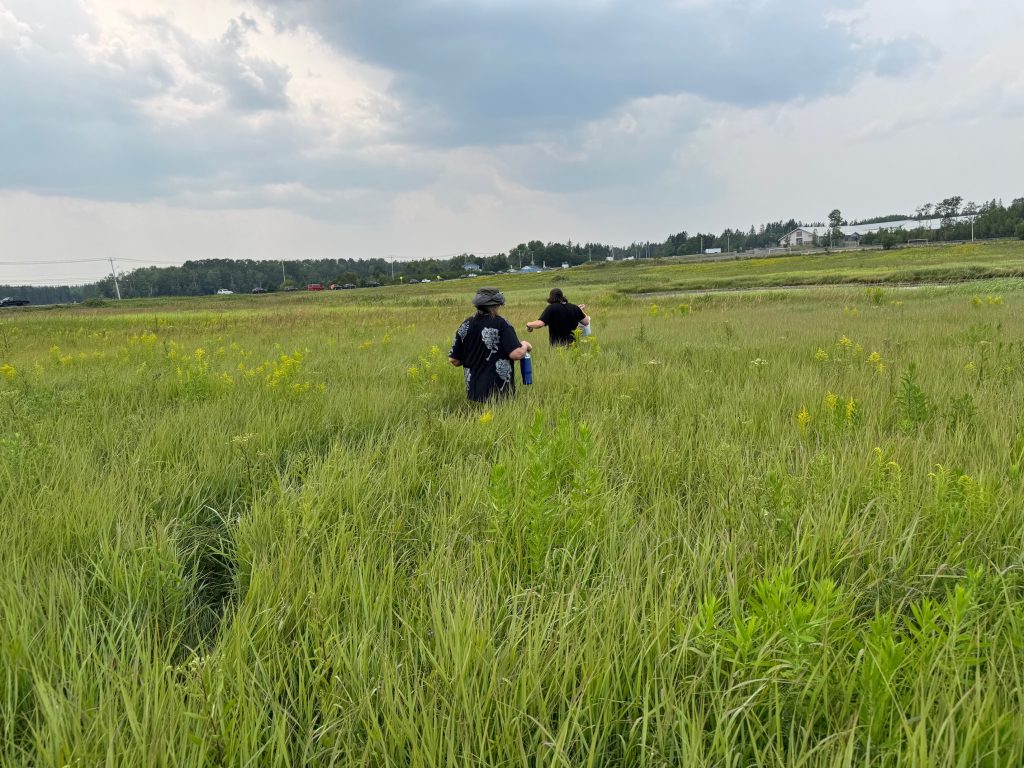
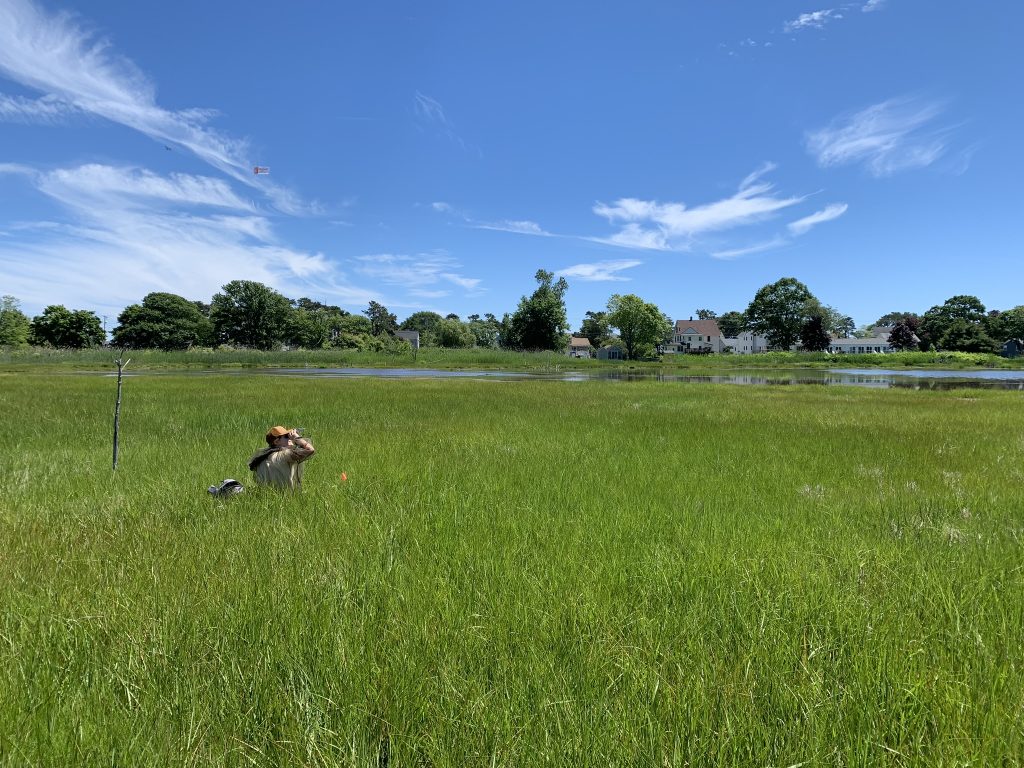
The Marsh as a Teacher
Johnson, who has been studying the Morse Mountain marshes for 25 years, has an intimate familiarity with the marsh landscape, from the quantitative data collected there via the LI-COR devices as well as other methods, including qualitative and experiential data. The college students on Johnson’s research team report experiencing a sense of calm while on the marsh as well as enthusiasm, appreciation, and increased responsibility.
Hayden Eckblom, one of Johnson’s students who was funded by Maine Sea Grant and spent the summer of 2023 working with Johnson on the study, says, “One of the special things about this kind of research is the intense feeling of responsibility connected to it. While in the marsh, you are acutely aware of a sense of stewardship and responsibility to ensure your work is thorough and accurate. While those are important aspects of any research, I never experienced them in that sense to the same degree I did in the marsh. I think this is largely due to how I came to understand and view the marsh as an entity, which we were all playing a vital role in understanding and protecting.”
Research that Restores Hope
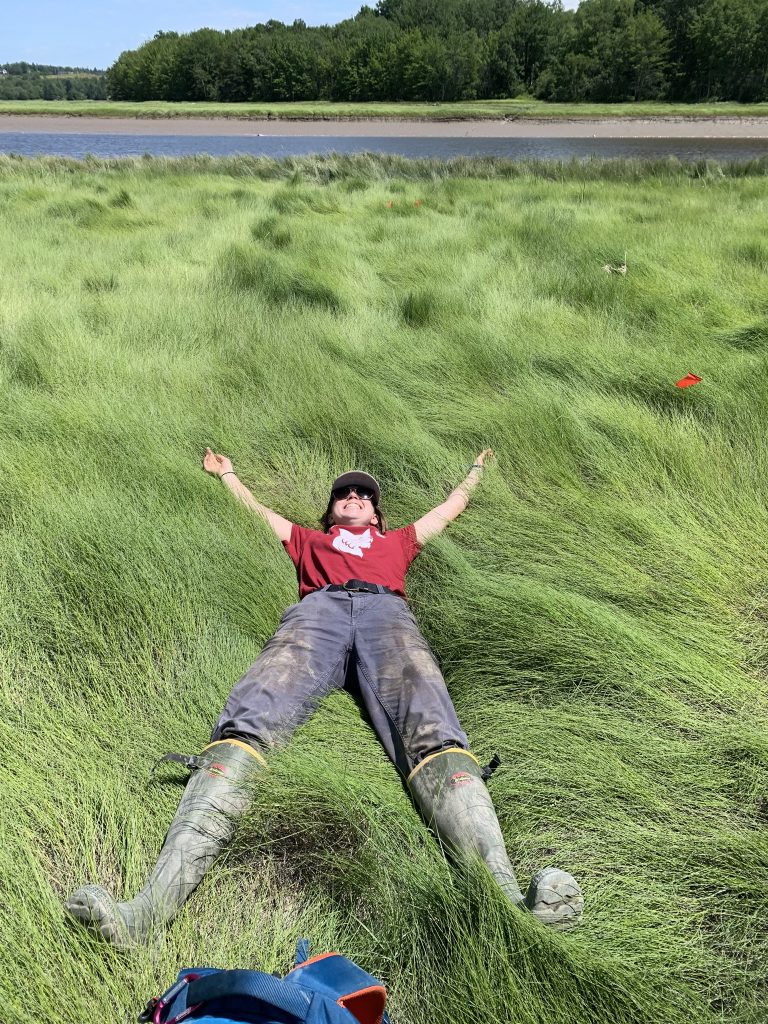
Johnson, who is one of the founders of the Maine Blue Carbon Network, notes that tidal marsh restoration is not just about the carbon. Flourishing tidal marshes provide habitat for commercially, recreationally, and culturally important fish species and a huge export of nutrients out into the nearshore coastal zone. They are also great at buffering against storm surges and filtering out toxins and nitrogen. Johnson strongly agrees with the rationale for supporting tidal marsh restoration laid out in the state’s “Maine Won’t Wait” climate action plan: “Restoration of unhealthy Maine marshes can enhance carbon uptake while increasing protection of coastlines and providing healthy habitat for important species that are part of our fisheries and cultural heritage. Marsh restoration is a win-win situation.”
Johnson and other collaborators from the Maine Blue Carbon Network organized a convening in October – the blue carbon science and policy symposium to talk to policymakers about the value of healthy blue carbon ecosystems, including salt marshes, eelgrass meadows, and kelp beds, in reducing carbon and increasing carbon drawdown across the state. The data from Johnson’s Maine Sea Grant-supported research to show what a healthy, resilient tidal marsh ecosystem looks like versus one that’s degraded.
Ultimately, Johnson hopes that this research and conversations about it can help Mainers make decisions over the next ten years that will allow these important ecosystems to exist far into the future. As Johnson’s students would likely agree, standing on the firm ground of a healthy tidal marsh is far more reassuring–physically, scientifically, and metaphorically–than the wobbles that come from standing atop a degraded marsh.
For further reading:
Eckblom, H., Marchand, E., Wilson, F., Dickson, K., Hollander, J., Sarrazin, A. 2024. Assessing the impact of farming practices on carbon stocks in the Sprague River Salt Marsh, Phippsburg, Maine (Conference abstract for Poster Presentation, American Geophysical Union, San Francisco, December 2023)
Hollander, J., Dickson, K., Eckblom, H., Marchand, E., Sarrazin, A., Wilson, F., Dostie, P., Johnson, B. The Impact of Tidal Restrictions on Carbon Cycling in Two Maine Salt Marshes (Conference abstract for Poster Presentation, American Geophysical Union, San Francisco, December 2023)
Richard, H., Salt Marsh Tidal Creek Restrictions in Maine, StoryMap, 2024
Exploring the Secrets of Marsh Happiness, NOAA Website
Maine Tidal Restriction Atlas, Maine DMR, Habitat and Community Resilience Tools, Webmapper
Dickson, K., 2024. Carbon dynamics upstream and downstream of a tidal restriction, Spurwink Marsh, Cape Elizabeth, Maine. Thesis, Department of Earth and Climate Sciences, Bates College.
Hollander, Jamie, 2024. Carbon Dynamics Upstream and Downstream of a Tidal Restriction in Drakes Island Salt Marsh, Wells, Maine. Honors Thesis, Department of Earth and Climate Sciences, Bates College.
Sarrazin, Anna, 2024. Tidal Restriction Affects Carbon Dynamics in the Jones Creek Salt Marsh, Scarborough, ME, USA. Honors Thesis, Department of Earth and Climate Sciences, Bates College.
Professor Beverly Johnson and Bates students study CO2 capture in the Sprague River salt marsh, Short Video by Bates College
Understanding Salt Marshes’ Climate Superpowers a short video by Little Heron Media
Margo Danahy, 2024. Short-term greenhouse gas dynamics and long term carbon storage in Southwestern Portion of Sprague Marsh, Phippsburg, Maine. Thesis, Department of Earth and Climate Sciences, Bates College.
Adi Kolf, 2025. The Impact of a Tidal Restriction on the Marsh-Forest Ecotone of Sprague Marsh, Phippsburg, Maine. Thesis, Department of Earth and Climate Sciences, Bates College.
Izzy Larson, 2025. Sweetgrass: Habitat Assessment and Plant Physiology in Salt Marshes. Thesis, Department of Earth and Climate Sciences, Bates College.
Adelle Welch, 2025. High Resolution Mapping of Carbon Stocks and Sequestration and Organic Matter Sources Over the Last 4,000 Years in the Sprague River Marsh, Phippsburg, Maine. Honors. Presented at EGU, 2025.
Posted 29 November 2025
